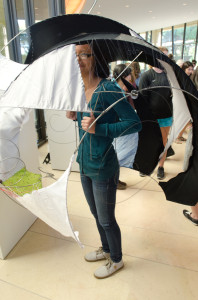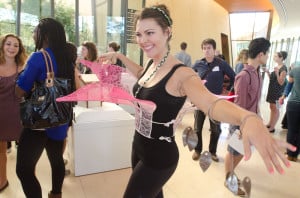As summer wound to a close, Stanford’s campus buzzed with the energy of students dancing, writing, painting and producing art of all forms. Although academic classes didn’t start until Sept. 23, over 100 rising sophomores, juniors and seniors arrived on the Farm three weeks early to participate in Arts Intensive, a dynamic arts-based immersion program.

Now in its fifth year, the program is modeled after Sophomore College, except that instead of exploring traditionally academic interests, students pursue artistic passions including sculpture, filmmaking, creative writing or dance.
Arts Intensive was conceptualized as a “rigorous and concentrated [program with] its focus in the arts,” according to Vice Provost for Undergraduate Education Harry Elam, who originated the program’s idea.
Each year, the course offerings are slightly different, and this year, the final showcase was held at Bing Concert Hall for the first time.
Louis Lagalante ’15, an Arts Intensive Program Assistant (AIPA) for the musical theater class this year and a student in the class last year, said that Arts Intensive provides a crucial validation of the arts at Stanford.
“I think the arts at Stanford are in tremendous danger,” Lagalante said. “[I’ve heard] many voices raising concerns that Stanford is becoming more of a start-up incubator and vocational school for entrepreneurs than an academic institution devoted to the pursuit of knowledge regardless of its profitability or mass-market appeal.”
Elam said that Arts Intensive is one element of a Stanford-wide initiative “to make the arts more vital as a component of the experience on campus.”
Additional art spaces planned for the next few years include a new Art and Art History building and a renovation of the Roble Gym, which will add a theater. The new Ways of Thinking/Ways of Doing undergraduate breadth requirements also emphasize the arts—in fact, Arts Intensive fulfills the Creative Expression component of the new requirements.
Students say that participating in the Arts Intensive program can provide opportunities to learn valuable skills.
“Filmmaking was interesting to me on both a practical and philosophical level,” said Julia Guenther ’14. “I not only saw [the filmmaking class] as an excellent opportunity to acquire video production and editing skills valuable for a career in marketing but also as a unique opportunity to engage with the complex medium that is film.”
Guenther added that taking a filmmaking class taught her to think in terms of systems, which Guenther thinks may help her in the working world.

Anna Maria Irion ’14, an architecture major, said she participated in the Arts Intensive sculpture class because she thought the class would be a good introduction to working in public art, a potential career interest.
For other students, however, the Arts Intensive program is an opportunity to explore interests outside their academic or career path. According to Elam, students of all backgrounds are encouraged to participate in Arts Intensive. He said the program was designed to provide “space for artists as well as for people who want to return to or experience the arts.”
“I think the creative part is really cool,” said McKenzie Andrews ’16, who took the filmmaking Arts Intensive class but plans to major in economics. “A lot of times in my regular classes I write papers and do problem sets, and this gives us much more creative license.”
Mia Diawara ’15 is majoring in science, technology and society but also served as an AIPA for the modern dance class in Arts Intensive.
“At a school where it can be difficult to find an arts emphasis amidst the larger presence of the STEM fields, having an entire program devoted to allowing students to pursue their [non-academic] passions is invaluable,” Diawara said. “It helps keep the campus, and the lives of its students, in balance.”
Adam Tobin ’93, a film lecturer in the Department of Art and Art History who taught a screenwriting class, said he appreciated the diversity of students within the program.
“It doesn’t matter to me whether students pursue a career in this or not,” Tobin said. “I really enjoy advising students who are pursuing film and screenwriting, but mostly I enjoy helping students understand a different way of thinking and storytelling than they’ve understood before.”
Participants also noted that the Arts Intensive program reduces the perceived loneliness of pursuing arts on campus.
“Arts Intensive is a powerful way to create a community of people doing art at the same time,” Lagalante said. “Arts Intensive shows Stanford students how many people there are on campus who pursue the arts with the same passion as they do and connects those people when they might not have ever met under other circumstances.”
Regardless of how it fits into a student’s plan, Elam said that Arts Intensive helps students attain what he sees as one of the ultimate goals of the Stanford experience.
“I would like to see students leave Stanford with creative confidence,” Elam said “This confidence to face new problems, to think about them [and solve them] creatively, that’s what makes great achievements.”
Contact Marisa Messina at mmessina ‘at’ stanford.edu.
